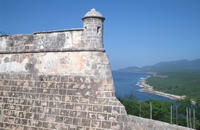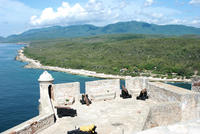You are in: Caribbean -> Cuba -> San Pedro de la Roca... , and traditional search or Image Gallery will yield results of this site only
San Pedro de la Roca Castle, Santiago de Cuba
| Site number: | 841 |
|
| Type of site: | Cultural | |
| Date: | 17th century | |
| Date of Inscription: | 1997 | |
| Location: | South America, Cuba, Provincia de Santiago de Cuba | |
Up to 75 images are shown here. Click on each for more details or on Image Gallery for more images.
| Description: | The construction of this immense series of ramparts on a rocky promontory, that were meant to protect the important port of Santiago, resulted from the 17th century commercial and political rivalries within the Caribbean region. This elaborate complex consisting of forts, warehouses, bastions and batteries is the most holistic, well-preserved example of Spanish-American military architecture, with a basis of Italian and Renaissance design principles. --WHMNet paraphrase from the description at WHC Site, where additional information is available. | |
| It was designed in 1637 by Giovan Battista Antonelli (also known as Juan Battista Antonelli), a member of a Milanese family of military engineers, on behalf of the governor of the city, Pedro de la Roca y Borja, as a defense against raiding pirates, although an earlier, smaller, fortification had been built between 1590 and 1610. Antonelli design was adapted to the situation of the fortress on the steep sides of the promontory (the morro from which the fortress gets its name) reaching into the bay. It was constructed on a series of terraces; there were four main levels and three large bulwarks to house the artillery. Supplies would be delivered by sea and then stored in the large warehouse, which was cut directly into the rock, or transported up to the top level which housed the citadel. Construction of the citadel took 42 years, starting in 1638 and finally being completed in 1700, though work on the fortification was spasmodic. Antonelli was recalled to Cuba in 1645, shortly after the massive project was started, and other examples of his work can be seen there in the twin forts of Fuerte del Cojimar and Fuerte de Santa Doratea de Luna de Chorrera. Some of the structures from the earlier fortification were later incorporated into the main structure. --Wikipedia. Text is available under the Creative Commons Attribution-ShareAlike License. | ||
| Source: | http://whc.unesco.org/en/list/841 | |
| Reference: | 1. UNESCO World Heritage Center, Site Page. | |


















